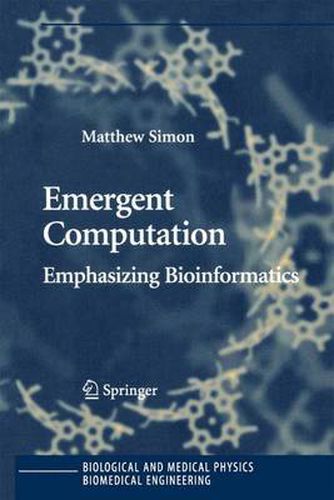Readings Newsletter
Become a Readings Member to make your shopping experience even easier.
Sign in or sign up for free!
You’re not far away from qualifying for FREE standard shipping within Australia
You’ve qualified for FREE standard shipping within Australia
The cart is loading…






This title is printed to order. This book may have been self-published. If so, we cannot guarantee the quality of the content. In the main most books will have gone through the editing process however some may not. We therefore suggest that you be aware of this before ordering this book. If in doubt check either the author or publisher’s details as we are unable to accept any returns unless they are faulty. Please contact us if you have any questions.
Emergent Computation emphasizes the interrelationship of the different classes of languages studied in mathematical linguistics (regular, context-free, context-sensitive, and type 0) with aspects to the biochemistry of DNA, RNA, and proteins. In addition, aspects of sequential machines such as parity checking and semi-groups are extended to the study of the Biochemistry of DNA, RNA, and proteins. Mention is also made of the relationship of algebraic topology, knot theory, complex fields, quaternions, and universal turing machines and the biochemistry of DNA, RNA, and proteins.
Emergent Computation tries to avoid an emphasis upon mathematical abstraction ( elegance ) at the expense of ignoring scientific facts known to Biochemists. Emergent Computation is based entirely upon papers published by scientists in well-known and respected professional journals. These papers are based upon current research. A few examples of what is not ignored to gain elegance :
DNA exists as triple and quadruple strands
Watson-Crick complementary bases have mismatches
There can be more than four bases in DNA
There are more than sixty-four codons
There may be more that twenty amino acids in proteins
While Emergent Computation emphasizes bioinformatics applications, the last chapter studies mathematical linguistics applied to areas such as languages found in birds, insects, medical applications, anthropology, etc.
Emergent Computation tries to avoid unnecessary mathematical abstraction while still being rigorous. The demands made upon the knowledge of chemistry or mathematics is minimized as well. The collected technical references are valuable in itself for additional reading.
$9.00 standard shipping within Australia
FREE standard shipping within Australia for orders over $100.00
Express & International shipping calculated at checkout
This title is printed to order. This book may have been self-published. If so, we cannot guarantee the quality of the content. In the main most books will have gone through the editing process however some may not. We therefore suggest that you be aware of this before ordering this book. If in doubt check either the author or publisher’s details as we are unable to accept any returns unless they are faulty. Please contact us if you have any questions.
Emergent Computation emphasizes the interrelationship of the different classes of languages studied in mathematical linguistics (regular, context-free, context-sensitive, and type 0) with aspects to the biochemistry of DNA, RNA, and proteins. In addition, aspects of sequential machines such as parity checking and semi-groups are extended to the study of the Biochemistry of DNA, RNA, and proteins. Mention is also made of the relationship of algebraic topology, knot theory, complex fields, quaternions, and universal turing machines and the biochemistry of DNA, RNA, and proteins.
Emergent Computation tries to avoid an emphasis upon mathematical abstraction ( elegance ) at the expense of ignoring scientific facts known to Biochemists. Emergent Computation is based entirely upon papers published by scientists in well-known and respected professional journals. These papers are based upon current research. A few examples of what is not ignored to gain elegance :
DNA exists as triple and quadruple strands
Watson-Crick complementary bases have mismatches
There can be more than four bases in DNA
There are more than sixty-four codons
There may be more that twenty amino acids in proteins
While Emergent Computation emphasizes bioinformatics applications, the last chapter studies mathematical linguistics applied to areas such as languages found in birds, insects, medical applications, anthropology, etc.
Emergent Computation tries to avoid unnecessary mathematical abstraction while still being rigorous. The demands made upon the knowledge of chemistry or mathematics is minimized as well. The collected technical references are valuable in itself for additional reading.